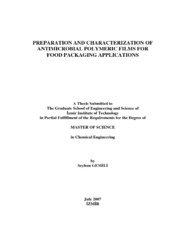Please use this identifier to cite or link to this item:
https://hdl.handle.net/11147/3849Full metadata record
| DC Field | Value | Language |
|---|---|---|
| dc.contributor.advisor | Alsoy Altınkaya, Sacide | en |
| dc.contributor.author | Gemili, Seyhun | - |
| dc.date.accessioned | 2014-07-22T13:52:30Z | - |
| dc.date.available | 2014-07-22T13:52:30Z | - |
| dc.date.issued | 2007 | en |
| dc.identifier.uri | http://hdl.handle.net/11147/3849 | - |
| dc.description | Thesis (Master)--Izmir Institute of Technology, Chemical Engineering, Izmir, 2007 | en |
| dc.description | Includes bibliographical references (leaves: 70-73) | en |
| dc.description | Text in English; Abstract: Turkish and English | en |
| dc.description | xiii, 69 leaves | en |
| dc.description.abstract | In this study, cellulose acetate (CA) based antimicrobial packaging materials containing lysozyme as an antimicrobial additive were developed. In order to achieve appropriate controlled release of antimicrobial agent, the structure of the films were changed from highly asymmetric and porous to dense ones by modulating the composition of the initial casting solution. The effectiveness of the films were then tested through measurement of soluble and immobilized lysozyme activity, release kinetics and antimicrobial activity on selected microorganisms. The highest release rate, soluble lysozyme activity and resulting antimicrobial activity (on E.coli) was obtained with the film prepared from 5 % CA solution including 1.5 % lysozyme. Increasing CA content in the casting solution decreased the porosity of the films, hence, reduced the release rate, maximum released activities and the antimicrobial activities of the films. On the other hand, immobilized activities and the tensile strength of the films increased. The mechanical properties of the antimicrobial films cast with 5 % and 10 % CA were similar to those of lysozyme free CA films. However, significant reductions in tensile strength and elongation values were observed for the antimicrobial films prepared with 15 % CA. Differences in the release rates, soluble, immobilized and antimicrobial activities at porous and dense surfaces of the films suggest that different surfaces of CA films can be employed for antimicrobial packaging according to the targeted shelf-life of the food products. When the films made with 5 % CA were stored at 4 °C for a maximal period of 105 days, an increase in soluble lysozyme and antimicrobial activities of the films were observed. The results demonstrate that CA films prepared in this study show promising potential to achieve controlled release in antimicrobial packaging. | en |
| dc.language.iso | en | en_US |
| dc.publisher | Izmir Institute of Technology | en |
| dc.rights | info:eu-repo/semantics/openAccess | en_US |
| dc.subject.lcc | TP374. G32 2007 | en |
| dc.subject.lcsh | Food--Packaging | en |
| dc.subject.lcsh | Polymers | en |
| dc.subject.lcsh | Thin films | en |
| dc.subject.lcsh | Anti-İnfective agents | en |
| dc.title | Preparation and characterization of antimicrobial polymeric films for food packaging applications | en_US |
| dc.type | Master Thesis | en_US |
| dc.institutionauthor | Gemili, Seyhun | - |
| dc.department | Thesis (Master)--İzmir Institute of Technology, Chemical Engineering | en_US |
| dc.relation.publicationcategory | Tez | en_US |
| item.fulltext | With Fulltext | - |
| item.grantfulltext | open | - |
| item.languageiso639-1 | en | - |
| item.openairecristype | http://purl.org/coar/resource_type/c_18cf | - |
| item.cerifentitytype | Publications | - |
| item.openairetype | Master Thesis | - |
| Appears in Collections: | Master Degree / Yüksek Lisans Tezleri | |
Files in This Item:
| File | Description | Size | Format | |
|---|---|---|---|---|
| T000651.pdf | MasterThesis | 1.46 MB | Adobe PDF |  View/Open |
CORE Recommender
Page view(s)
206
checked on Nov 18, 2024
Download(s)
124
checked on Nov 18, 2024
Google ScholarTM
Check
Items in GCRIS Repository are protected by copyright, with all rights reserved, unless otherwise indicated.